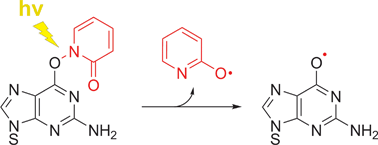Photolabile N-hydroxypyrid-2(1H)-one derivatives of guanine nucleosides: a new method for independent guanine radical generation†
Abstract
One-electron oxidized

* Corresponding authors
a
Organic Chemistry Laboratory, Department of Chemistry, University of Athens, Panepistimiopolis, Greece
E-mail:
gimisis@chem.uoa.gr
Fax: +30 2107274761
Tel: +30 2107274928
b Instituto de Tecnología Química, Universidad Politécnica de Valencia, Camino de Vera s/n, Spain
One-electron oxidized

 Please wait while we load your content...
Something went wrong. Try again?
Please wait while we load your content...
Something went wrong. Try again?
P. Kaloudis, C. Paris, D. Vrantza, S. Encinas, R. Pérez-Ruiz, M. A. Miranda and T. Gimisis, Org. Biomol. Chem., 2009, 7, 4965 DOI: 10.1039/B909138F
To request permission to reproduce material from this article, please go to the Copyright Clearance Center request page.
If you are an author contributing to an RSC publication, you do not need to request permission provided correct acknowledgement is given.
If you are the author of this article, you do not need to request permission to reproduce figures and diagrams provided correct acknowledgement is given. If you want to reproduce the whole article in a third-party publication (excluding your thesis/dissertation for which permission is not required) please go to the Copyright Clearance Center request page.
Read more about how to correctly acknowledge RSC content.
 Fetching data from CrossRef.
Fetching data from CrossRef.
This may take some time to load.
Loading related content
